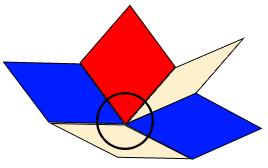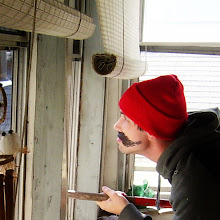Basic Game Rules:
Setup:
-take 7 of each of the three shapes and make a small, 21 piece mandala (14 sided polygon). For example:

-player 1 starts with 4 dark beads
-player 2 starts with 3 light beads
-player 1 goes first
first round:
-player 1 places a bead on any intersection on the board

-player 2 places a light bead on an open intersection on the board, attempting to match player 1’s ratio of shapes (in the example above, the ratio of player 1’s intersection is 2/2/1 because it has two blue, two white, and 1 red shape). An exact match doesn’t count.
-if player 2 is successful, they take the bead of their opponent off the board and into their own hand. The space in which the bead sat cannot be used for 1 turn (note, this rule can change in larger versions of the game to say that the space cannot be used for the rest of the game). Player 2 gets a point.
-if player 2 is not successful, no beads are taken away and nobody gets a point. It becomes player 1’s turn again. Player 1 will then do the same as player 2, attempting to match player 2’s intersection ratio.
Strategies and other things to note:
-if a player puts a bead down and their opponent has multiple beads on the board with that same ratio, the player will take all of their opponents beads that match that ratio, and gain 1 point for each capture.
-captured beads are playable and they work in play as if your opponent had played them—any captured beads (captured beads will be your own color) will go to your opponent and your opponent will gain 1 point for any bead you capture for them.
-At the end of the game—when a player has run out of beads—any remaining beads in hand will be counted as either 1 point gained or subtracted (for every bead of your opponent you lose 1 point, for every bead of your own you gain 1 point). The player with the most points wins.

No comments:
Post a Comment